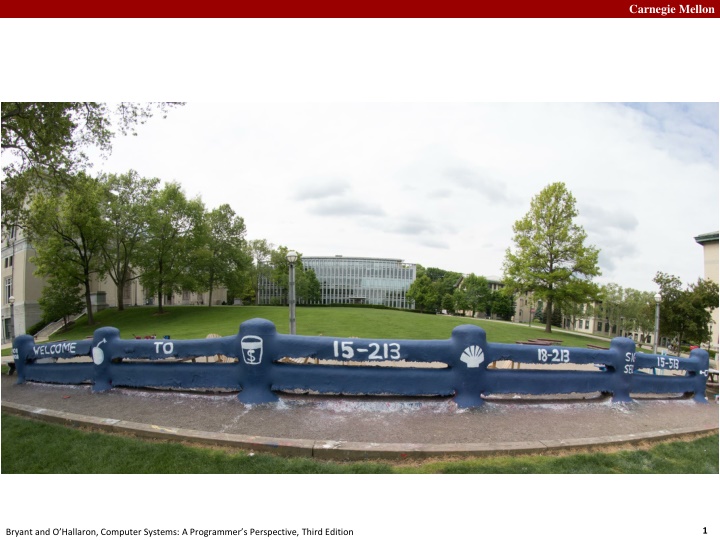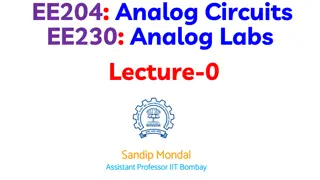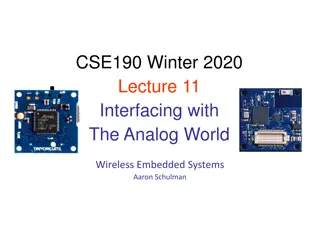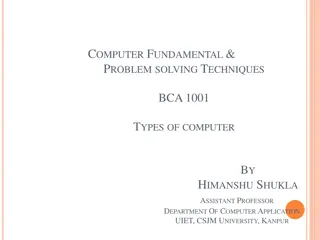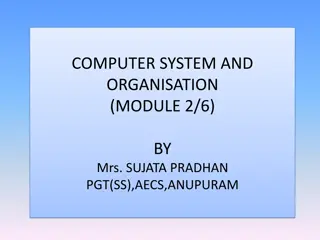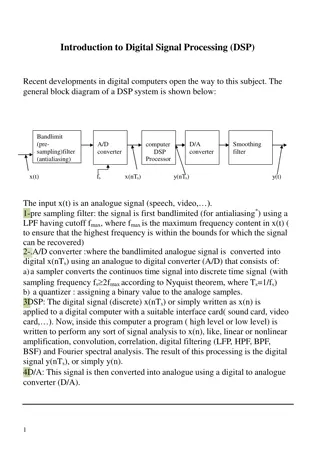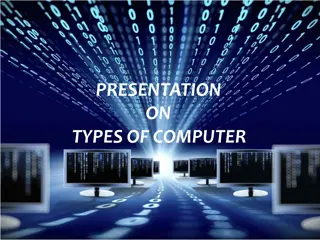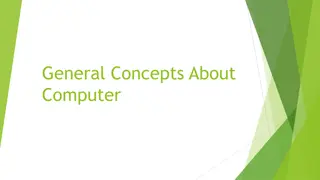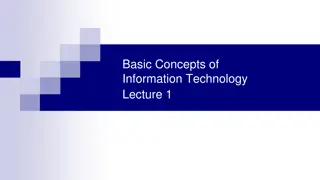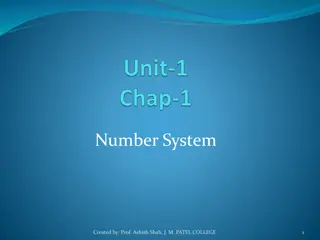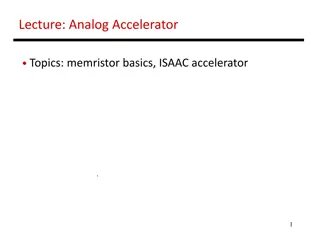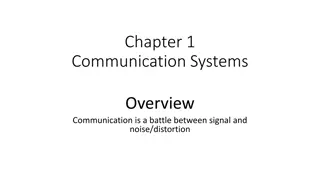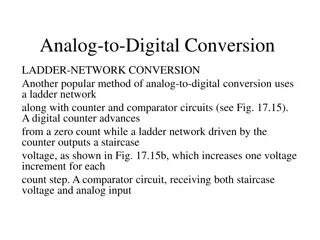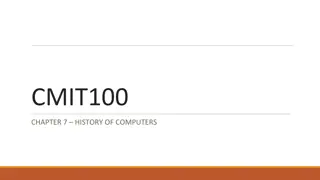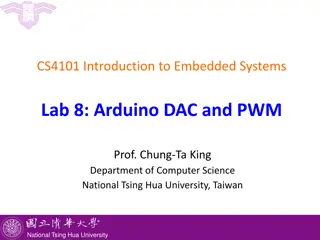Analog Computers: The Challenge Unveiled
Analog computers, a precursor to digital ones, operate differently due to component tolerances and environmental factors. Signal attenuation, energy loss, and noise interference make precise representation and communication challenging, reflecting the uniqueness of analog systems.
Download Presentation

Please find below an Image/Link to download the presentation.
The content on the website is provided AS IS for your information and personal use only. It may not be sold, licensed, or shared on other websites without obtaining consent from the author.If you encounter any issues during the download, it is possible that the publisher has removed the file from their server.
You are allowed to download the files provided on this website for personal or commercial use, subject to the condition that they are used lawfully. All files are the property of their respective owners.
The content on the website is provided AS IS for your information and personal use only. It may not be sold, licensed, or shared on other websites without obtaining consent from the author.
E N D
Presentation Transcript
Carnegie Mellon 1 Bryant and O Hallaron, Computer Systems: A Programmer s Perspective, Third Edition
Carnegie Mellon Bits, Bytes and Integers 14-513/18-613: Introduction to Computer Systems 2ndand 3rd Lectures, May. 20-21, 2020 2 Bryant and O Hallaron, Computer Systems: A Programmer s Perspective, Third Edition
Carnegie Mellon Announcements CMU Computing and Linux Boot Camp Monday evening during regular class time A Quick Start Guide put together by your hard-working TAs has been posted to Piazza and the course Web site to help you get started until then. Autolab has been created, but I am still configuring it. You don t need it to start lab 0, which is posted to the Web site It will be available in plenty of time to turn in lab 0 and for the rest of the labs thereafter. Reminder: I ve got no control over the waitlist I ve asked the departments and programs to let everyone in I ve let the departments and programs know that we have enough TA applicants to hire enough great TAs to fully support the course In the summer, the departments have to work through each student s circumstance one-by-one to do the add. It can take time. A lot of time. 3 Bryant and O Hallaron, Computer Systems: A Programmer s Perspective, Third Edition
Carnegie Mellon Analog Computers Before digital computers there were analog computers. Consider a couple of simple analog computers: A simple circuit can allow one to adjust voltages using variable resistors and measure the output using a volt meter: A simple network of adjustable parallel resistors can allow one to find the average of the inputs. https://www.daycounter.com/Calculators/Voltage-Summer/Voltage- Summer-Calculator.phtml https://www.quora.com/What-is-the-most-basic-voltage-adder-circuit- without-a-transistor-op-amp-and-any-external-supply 4 Bryant and O Hallaron, Computer Systems: A Programmer s Perspective, Third Edition
Carnegie Mellon The Challenge of Analog Computers All components suffer from tolerances, and noise Components aren t manufacturer exactly The performance of components varies with the environment and as they age Signals are attenuated and affected by resistance, inductance, capacitance, etc, as they travel through conductors Energy is lost during storage Conductors act as antennas and collect noise These properties mean that nothing is represented the same way over time and space and nothing can be communicated or duplicated or compared exactly 5 Bryant and O Hallaron, Computer Systems: A Programmer s Perspective, Third Edition
Carnegie Mellon Needing Less Accuracy, Precision is Better We don t try to measure exactly We just ask, is it high enough to be On , or Is it low enough to be Off . We have two states, so we have a binary, or 2-ary, system. We represent these states as 0 and 1 Now we can easily interpret, communicate, and duplicate signals well enough to know what they mean. 0 1 0 1.1V 0.9V 0.2V 0.0V 6 Bryant and O Hallaron, Computer Systems: A Programmer s Perspective, Third Edition
Carnegie Mellon Binary Representation By encoding/interpreting sets of bits in various ways, we can represent different things: Operations to be executed by the processor Numbers Enumerable things, such as text characters As long as we can assign it to a discrete number, we can represent it in binary 7 Bryant and O Hallaron, Computer Systems: A Programmer s Perspective, Third Edition
Carnegie Mellon Binary Representation: Simple Numbers Binary representation leads to a simple binary, i.e. base-2, numbering system 0 represents 0 1 represents 1 Each place represents a power of two, exactly as each place in our usual base 10 , 10-ary numbering system represents a power of 10 8 Bryant and O Hallaron, Computer Systems: A Programmer s Perspective, Third Edition
Carnegie Mellon Binary Representation: Simple Numbers For example, we can count in binary, a base-2 numbering system 000, 001, 010, 011, 100, 101, 110, 111, 000 = 0*22 + 0*21 + 0*20 = 0 (in decimal) 001 = 0*22 + 0*21 + 1*20 = 1 (in decimal) 010 = 0*22 + 1*21 + 0*20 = 2 (in decimal) 011 = 0*22 + 1*21 + 1*20 = 3 (in decimal) Etc. For reference, consider some base-10 examples: 000 = 0*102 + 0*101 + 0*100 001 = 0*102 + 0*101 + 1*100 357 = 3*102 + 5*101 + 7*20 9 Bryant and O Hallaron, Computer Systems: A Programmer s Perspective, Third Edition
Carnegie Mellon Binary Representation: ASCII Table 0 (decimal) = 000 (binary) 1 (decimal) = 001 (binary) 2 (decimal) = 010 (binary) Etc. 10 Bryant and O Hallaron, Computer Systems: A Programmer s Perspective, Third Edition
Carnegie Mellon Encoding Byte Values Bits are very small. It helps to consider groups of them, e.g. Bytes A Byte = 8 bits Binary 000000002 to 111111112 Decimal: 010 to 25510 11 Bryant and O Hallaron, Computer Systems: A Programmer s Perspective, Third Edition
Carnegie Mellon Hexadecimal and Octal Writing out numbers in binary takes too many digits We want a way to represent numbers more densely such that fewer digits are required But also such that it is easy to get at the bits that we want Any power-of-two base provides this property Octal, e.g. base-8, and Decimal, e.g. base-16 are the closest to our familiar base-10. Each has been used by computer people over time Hexadecimal is often preferred because it is denser. 12 Bryant and O Hallaron, Computer Systems: A Programmer s Perspective, Third Edition
Carnegie Mellon Hexadecimal 0 1 2 3 4 5 6 7 8 9 A B C D E F 0 1 2 3 4 5 6 7 8 9 10 11 12 13 14 15 0000 0001 0010 0011 0100 0101 0110 0111 1000 1001 1010 1011 1100 1101 1110 1111 Hexadecimal 0016 to FF16 Base 16 number representation Use characters 0 to 9 and A to F Consider 1A2B in Hexadecimal: 1*163 + A*162 + 2*161 + B*160 1*163 + 10*162 + 2*161 + 11*160 = 6699 (decimal) The C Language prefixes hexadecimal numbers with 0x so they aren t confused with decimal numbers Write FA1D37B16 in C as 15213: 0011 1011 0110 1101 0xFA1D37B 3 B 6 D 0xfa1d37b 13 Bryant and O Hallaron, Computer Systems: A Programmer s Perspective, Third Edition
Carnegie Mellon Hexadecimal To Binary It is straight-forward to convert a hexadecimal number to binary: Groups of 4 digits represent 16 possibilities, 0-15, i.e. hexadeximal 0-F Group the hex digits into groups of 4 0 0 0000 1 1 0001 2 2 0010 3 3 0011 4 4 0100 5 5 0101 6 6 0110 7 7 0111 8 8 1000 9 9 1001 A 10 1010 B 11 1011 C 12 1100 D 13 1101 E 14 1110 F 15 1111 Start on the left side! If there aren t enough digits, leading 0s can be added on the left, but not on the right. Convert each group of 4 bits into the corresponding hex digit. The concatenation of all of the hex digits is the hex number, because each hex digit represents the same thing as the 4 bits it represents. Converting from hex to binary is the reverse process. 15213: 0011 1011 0110 1101 3 B 6 D 14 Bryant and O Hallaron, Computer Systems: A Programmer s Perspective, Third Edition
Carnegie Mellon Common Data Types In the C Language Because resources are finite, a fixed amount of memory is usually allocated to data types, including numbers. This amount of memory limits their range and/or precision. We ll talk about that soon The table below shows some examples for the C programming Language C Data Type Typical 32-bit Typical 64-bit x86-64 char 1 1 1 short 2 2 2 int 4 4 4 long 4 8 8 float 4 4 4 double 8 8 8 pointer 4 8 8 15 Bryant and O Hallaron, Computer Systems: A Programmer s Perspective, Third Edition
Carnegie Mellon Boolean Algebra Developed by George Boole in 19th Century Algebraic representation of logic Encode True as 1 and False as 0 And Or A&B = 1 when both A=1 and B=1 A|B = 1 when either A=1 or B=1 Not Exclusive-Or (Xor) ~A = 1 when A=0 A^B = 1 when either A=1 or B=1, but not both 16 Bryant and O Hallaron, Computer Systems: A Programmer s Perspective, Third Edition
Carnegie Mellon General Boolean Algebras Operate on Bit Vectors Operations applied bitwise 01101001 & 01010101 01000001 01000001 01101001 | 01010101 01111101 01111101 01101001 ^ 01010101 00111100 00111100 ~ 01010101 10101010 10101010 All of the Properties of Boolean Algebra Apply 17 Bryant and O Hallaron, Computer Systems: A Programmer s Perspective, Third Edition
Carnegie Mellon Example: Representing & Manipulating Sets Representation Width w bit vector represents subsets of {0, , w 1} aj = 1 if j A 01101001 { 0, 3, 5, 6 } 76543210 01010101 { 0, 2, 4, 6 } 76543210 Operations & Intersection | Union ^ Symmetric difference ~ Complement 01000001 01111101 00111100 10101010 { 0, 6 } { 0, 2, 3, 4, 5, 6 } { 2, 3, 4, 5 } { 1, 3, 5, 7 } 18 Bryant and O Hallaron, Computer Systems: A Programmer s Perspective, Third Edition
Carnegie Mellon Bit-Level Operations in C Operations &, |, ~, ^ Available in C Apply to any integral data type 0 1 2 3 4 5 6 7 8 9 A B C D E F 0 1 2 3 4 5 6 7 8 9 10 11 12 13 14 15 0000 0001 0010 0011 0100 0101 0110 0111 1000 1001 1010 1011 1100 1101 1110 1111 long, int, short, char, unsigned View arguments as bit vectors Arguments applied bit-wise Examples (Char data type) ~0x41 0xBE ~010000012 101111102 ~0x00 0xFF ~000000002 111111112 0x69 & 0x55 0x41 011010012 & 010101012 010000012 0x69 | 0x55 0x7D 011010012 | 010101012 011111012 19 Bryant and O Hallaron, Computer Systems: A Programmer s Perspective, Third Edition
Carnegie Mellon Bit-Level Operations in C Operations &, |, ~, ^ Available in C Operations &, |, ~, ^ Available in C Apply to any integral data type Apply to any integral data type 0 1 2 3 4 5 6 7 8 9 A B C D E F 0 1 2 3 4 5 6 7 8 9 10 11 12 13 14 15 0000 0001 0010 0011 0100 0101 0110 0111 1000 1001 1010 1011 1100 1101 1110 1111 long, int, short, char, unsigned View arguments as bit vectors Arguments applied bit-wise Arguments applied bit-wise long, int, short, char, unsigned View arguments as bit vectors Examples (Char data type) Examples (Char data type) ~0x41 0xBE ~0x41 0xBE ~010000012 101111102 ~0x00 0xFF ~0x00 0xFF ~0100 00012 1011 11102 ~000000002 111111112 0x69 & 0x55 0x41 0x69 & 0x55 0x41 ~0000 00002 1111 11112 011010012 & 010101012 010000012 0x69 | 0x55 0x7D 0x69 | 0x55 0x7D 0110 10012 & 0101 01012 0100 00012 011010012 | 010101012 011111012 0110 10012 | 0101 01012 0111 11012 20 Bryant and O Hallaron, Computer Systems: A Programmer s Perspective, Third Edition
Carnegie Mellon Contrast: Logic Operations in C Contrast to Bit-Level Operators Logic Operations: &&, ||, ! View 0 as False Anything nonzero as True Always return 0 or 1 Early termination Examples (char data type) !0x41 0x00 !0x00 0x01 !!0x41 0x01 Watch out for && vs. & (and || vs. |) Super common C programming pitfall! 0x69 && 0x55 0x01 0x69 || 0x55 0x01 p && *p (avoids null pointer access) 21 Bryant and O Hallaron, Computer Systems: A Programmer s Perspective, Third Edition
Carnegie Mellon Shift Operations Left Shift: x << y Shift bit-vector x left y positions Throw away extra bits on left Argument x 01100010 << 3 00010000 00010000 00010000 Log. >> 2 00011000 00011000 00011000 Fill with 0 s on right Arith. >> 2 00011000 00011000 00011000 Right Shift: x >> y Shift bit-vector x right y positions Argument x 10100010 Throw away extra bits on right Logical shift << 3 00010000 00010000 00010000 Fill with 0 s on left Arithmetic shift Log. >> 2 00101000 00101000 00101000 Arith. >> 2 11101000 11101000 11 11101000 Replicate most significant bit on left Undefined Behavior Shift amount < 0 or word size 22 Bryant and O Hallaron, Computer Systems: A Programmer s Perspective, Third Edition
Carnegie Mellon Binary Number Lines In binary, the number of bits in the data type size determines the number of points on the number line. We can assign the points any meaning we d like Consider the following examples: 1 bit number line 0 1 2 bit number line 00 01 10 11 3 bit number line 000 001 010 011 100 101 110 111 23 Bryant and O Hallaron, Computer Systems: A Programmer s Perspective, Third Edition
Carnegie Mellon Some Purely Imaginary Examples 3 bit number line -1/16 -1/8 -1/4 0 1/16 1/8 1/4 1/2 0 1 2 3 4 5 6 7 -4 -3 -2 -1 0 1 2 3 -2 -1.5 -1 -0.5 0 0.5 1 1.5 A B C D E F G H 24 Bryant and O Hallaron, Computer Systems: A Programmer s Perspective, Third Edition
Carnegie Mellon Overflow Let s consider a simple 3 digit number line: 0 1 2 3 4 5 6 000 001 010 011 100 101 110 111 7 What happens if we add 1 to 7? In other words, what happens if we add 1 to 111? 111+ 001 = 1 000 But, we only get 3 bits so we lose the leading-1. This is called overflow The result is 000 25 Bryant and O Hallaron, Computer Systems: A Programmer s Perspective, Third Edition
Carnegie Mellon Modulus Arithmetic Let s explore this idea of overflow some more 111 + 001 = 1 000 = 000 111 + 010 = 1 001 = 001 111 + 011 = 1 010 = 010 111 + 100 = 1 011 = 011 111 + 110 = 1 101 = 101 111 + 111 = 1 110 = 110 So, arithmetic wraps around when it gets too positive 26 Bryant and O Hallaron, Computer Systems: A Programmer s Perspective, Third Edition
Carnegie Mellon Unsigned and Non-Negative Integers We ll use the term ints to mean the finite set of integer numbers that we can represent on a number line enumerated by some fixed number of bits, i.e. bit width. We normally represent unsigned and non-negative int using simple binary as we have already discussed An unsigned int is any int on a number line, e.g. of a data type, that doesn t contain any negative numbers A non-negative number is a number greater than or equal to (>=) 0 on a number line, e.g. of a data type, that does contain negative numbers 27 Bryant and O Hallaron, Computer Systems: A Programmer s Perspective, Third Edition
Carnegie Mellon How represent negative Numbers? We could use the leading bit as a sign bit: 0 means non-negative 1 means negative 000 001 010 011 100 101 110 111 0 1 2 3 -0 -1 -2 -3 This has some benefits It lets us represent negative and non-negative numbers 0 represents 0 It also has some drawbacks There is a -0, which is the same as 0, except that it is different How to add such numbers 1 + -1 should equal 0 But, by simple math, 001 + 101 = 110, which is -2? 28 Bryant and O Hallaron, Computer Systems: A Programmer s Perspective, Third Edition
Carnegie Mellon A Magic Trick! Let s just start with three ideas: 1 should be represented as 1 -1 + 1 = 0 We want addition to work in the familiar way, with simple rules. We want a situation where -1 + 1 = 0 Consider a 3 bit number: 001 + -1 = 0 001 + 111 = 0 Remember 001 + 111 = 1 000, and the leading one is lost to overflow. -1 = 111 Yep! 29 Bryant and O Hallaron, Computer Systems: A Programmer s Perspective, Third Edition
Carnegie Mellon Negative Numbers Well, if 111 is -1, what is -2? -1 - 1 111 001 = 110 Does that really work? If it does -2 + 2 = 0 110 + 010 = 1 000 = 000 -2 + 5 should be 3, right? 110 + 101 = 1 011 = 011 In general -x = -1 - x 30 Bryant and O Hallaron, Computer Systems: A Programmer s Perspective, Third Edition
Carnegie Mellon Finding x the easy way Given a non-negative number in binary, e.g. 5, represented with a fixed bit width, e.g. 4 0101 We can find its negative by flipping each bit and adding 1 0101 This is 5 1010 This is the ones complement of 5 , e.g. 5 with bits flipped 1011 This is the twos complement of 5 , e.g. 5 with the bits flipped and 1 added 0101 + 1011 = 1 0000 = 0000 Because of the fixed with, the two s complement of a number can be used as its negative. 31 Bryant and O Hallaron, Computer Systems: A Programmer s Perspective, Third Edition
Carnegie Mellon Why Does This Work? Consider any number and its complement: 0101 1010 They are called complements because complementary bits are set. As a result, if they are added, all bits are necessarily set: 0101 + 1010 = 1111 Adding 1 to the sum of a number and its complement necessarily results in a 0 due to overflow (0101 + 1010) + 1 = 1111 + 1 = 1 0000 = 0000 And if x + y = 0, y must equal x Bryant and O Hallaron, Computer Systems: A Programmer s Perspective, Third Edition So if x + TwosComplement(x) + 1 = 0 32
Carnegie Mellon Why Does This Work? Cont. If x + y = 0 y must equal x So if x + (TwosComplement(x) + 1) = 0 TwosComplement(x) + 1 must equal x Another way of looking at it: if x + (TwosComplement(x) + 1) = 0 x + TwosComplement(x) = -1 x = -1 - TwosComplement(x) -x = 1 + TwosComplement(x) 33 Bryant and O Hallaron, Computer Systems: A Programmer s Perspective, Third Edition
Carnegie Mellon Two-complement Encoding Example (Cont.) x = 15213: 00111011 01101101 y = -15213: 11000100 10010011 Weight 15213 1 0 1 1 0 1 1 0 1 1 0 1 1 1 0 0 -15213 1 1 0 0 1 0 0 1 0 0 1 0 0 0 1 1 1 2 4 8 1 0 4 8 0 1 2 0 0 16 32 64 128 256 512 1024 2048 4096 8192 16384 -32768 Sum 16 0 0 128 32 64 0 256 512 0 0 0 1024 2048 4096 8192 0 0 0 0 0 16384 -32768 -15213 15213 34 Bryant and O Hallaron, Computer Systems: A Programmer s Perspective, Third Edition
Carnegie Mellon Negation: Complement & Increment Negate through complement and increase ~x + 1 == -x Example Observation: ~x + x == 1111 111 == -1 x 1 0 0 1 1 1 0 1 + ~x 0 1 1 0 0 0 1 0 -1 1 1 1 1 1 1 1 1 x = 15213 x ~x ~x+1 y Decimal 15213 3B 6D 00111011 01101101 -15214 C4 92 11000100 10010010 -15213 C4 93 11000100 10010011 -15213 C4 93 11000100 10010011 Hex Binary 35 Bryant and O Hallaron, Computer Systems: A Programmer s Perspective, Third Edition
Carnegie Mellon Complement & Increment Examples x = 0 0 ~0 ~0+1 Decimal Hex 00 00 00000000 00000000 FF FF 11111111 11111111 00 00 00000000 00000000 Binary 0 -1 0 x = Tmin (The most negative two s complement number) x ~x ~x+1 Decimal -32768 80 00 10000000 00000000 32767 7F FF 01111111 11111111 -32768 80 00 10000000 00000000 Hex Binary Canonical counter example 36 Bryant and O Hallaron, Computer Systems: A Programmer s Perspective, Third Edition
Carnegie Mellon Encoding Integers: Dense Form Unsigned Two s Complement w 1 w 2 xw 1 2w 1+ xi 2i xi 2i = = B2U(X) B2T(X) i=0 i=0 short int x = 15213; short int y = -15213; Sign Bit C does not mandate using two s complement But, most machines do, and we will assume so C short 2 bytes long x y Decimal 15213 -15213 Hex 3B 6D 00111011 01101101 C4 93 11000100 10010011 Binary Sign Bit For 2 s complement, most significant bit indicates sign 0 for nonnegative 1 for negative 37 Bryant and O Hallaron, Computer Systems: A Programmer s Perspective, Third Edition
Carnegie Mellon Numeric Ranges Unsigned Values UMin 000 0 UMax 111 1 Two s Complement Values TMin 100 0 TMax 011 1 Minus 1 111 1 = 0 2w 1 = = 2w 1 2w 1 1 = Values for W = 16 UMax TMax TMin -1 0 Decimal 65535 32767 -32768 Hex FF FF 11111111 11111111 7F FF 01111111 11111111 80 00 10000000 00000000 FF FF 11111111 11111111 00 00 00000000 00000000 Binary -1 0 38 Bryant and O Hallaron, Computer Systems: A Programmer s Perspective, Third Edition
Carnegie Mellon Values for Different Word Sizes W 8 255 127 -128 16 65,535 32,767 -32,768 32 64 UMax TMax TMin 4,294,967,295 2,147,483,647 -2,147,483,648 18,446,744,073,709,551,615 9,223,372,036,854,775,807 -9,223,372,036,854,775,808 Observations |TMin | = C Programming #include <limits.h> Declares constants, e.g., ULONG_MAX LONG_MAX LONG_MIN Values platform specific TMax + 1 Asymmetric range UMax = Question: abs(TMin)? 2 * TMax + 1 39 Bryant and O Hallaron, Computer Systems: A Programmer s Perspective, Third Edition
Carnegie Mellon Unsigned & Signed Numeric Values Equivalence Same encodings for nonnegative values X B2U(X) 0 1 2 3 4 5 6 7 B2T(X) 0 1 2 3 4 5 6 7 8 7 6 5 4 3 2 1 0000 0001 0010 0011 0100 0101 0110 0111 1000 1001 1010 1011 1100 1101 1110 1111 Uniqueness Every bit pattern represents unique integer value Each representable integer has unique bit encoding Can Invert Mappings U2B(x) = B2U-1(x) 8 9 10 11 12 13 14 15 Bit pattern for unsigned integer T2B(x) = B2T-1(x) Bit pattern for two s comp integer 40 Bryant and O Hallaron, Computer Systems: A Programmer s Perspective, Third Edition
Carnegie Mellon Today: Bits, Bytes, and Integers Representing information as bits Bit-level manipulations Integers Representation: unsigned and signed Conversion, casting Expanding, truncating Addition, negation, multiplication, shifting Summary Representations in memory, pointers, strings 41 Bryant and O Hallaron, Computer Systems: A Programmer s Perspective, Third Edition
Carnegie Mellon Mapping Between Signed & Unsigned Unsigned Two s Complement T2U x ux T2B B2U X Maintain Same Bit Pattern Two s Complement x Unsigned U2T ux U2B B2T X Maintain Same Bit Pattern Mappings between unsigned and two s complement numbers: Keep bit representations and reinterpret 42 Bryant and O Hallaron, Computer Systems: A Programmer s Perspective, Third Edition
Carnegie Mellon Mapping Signed Unsigned Bits Signed Unsigned 0000 0001 0010 0011 0100 0101 0110 0111 1000 1001 1010 1011 1100 1101 1110 1111 0 1 2 3 4 5 6 7 0 1 2 3 4 5 6 7 8 9 T2U U2T -8 -7 -6 -5 -4 -3 -2 -1 10 11 12 13 14 15 43 Bryant and O Hallaron, Computer Systems: A Programmer s Perspective, Third Edition
Carnegie Mellon Mapping Signed Unsigned Bits Signed Unsigned 0000 0001 0010 0011 0100 0101 0110 0111 1000 1001 1010 1011 1100 1101 1110 1111 0 1 2 3 4 5 6 7 0 1 2 3 4 5 6 7 8 9 = -8 -7 -6 -5 -4 -3 -2 -1 10 11 12 13 14 15 +/- 16 44 Bryant and O Hallaron, Computer Systems: A Programmer s Perspective, Third Edition
Carnegie Mellon Relation between Signed & Unsigned Unsigned Two s Complement T2U x ux T2B B2U X Maintain Same Bit Pattern w 1 0 ux x + + + - + + + + + + + + Large negative weight becomes Large positive weight 45 Bryant and O Hallaron, Computer Systems: A Programmer s Perspective, Third Edition
Carnegie Mellon Conversion Visualized 2 s Comp. Ordering Inversion Negative Big Positive Unsigned UMax UMax 1 TMax + 1 Unsigned Range TMax TMax 2 s Complement 0 0 Range 1 2 TMin 46 Bryant and O Hallaron, Computer Systems: A Programmer s Perspective, Third Edition
Carnegie Mellon Signed vs. Unsigned in C Constants By default are considered to be signed integers Unsigned if have U as suffix 0U, 4294967259U Casting Explicit casting between signed & unsigned same as U2T and T2U int tx, ty; unsigned ux, uy; tx = (int) ux; uy = (unsigned) ty; Implicit casting also occurs via assignments and procedure calls tx = ux; int fun(unsigned u); uy = ty; uy = fun(tx); 47 Bryant and O Hallaron, Computer Systems: A Programmer s Perspective, Third Edition
Carnegie Mellon Casting Surprises Expression Evaluation If there is a mix of unsigned and signed in single expression, signed values implicitly cast to unsigned Including comparison operations <, >, ==, <=, >= Examples for W = 32: TMIN = -2,147,483,648 , TMAX = 2,147,483,647 Constant2 0 0U -1 0 -1 0U 2147483647 -2147483647-1 2147483647U -2147483647-1 -1 -2 (unsigned)-1 -2 2147483647 2147483648U Constant1 Relation Evaluation 0 0U 0 0U -2147483648 -2147483648 -2 -2 2147483648U (int) 2147483648U (int) 2147483648U == < > > < > > < > unsigned signed unsigned signed unsigned signed unsigned unsigned signed -1 -1 2147483647 2147483647U -1 (unsigned) -1 2147483647 2147483647 2147483647 48 Bryant and O Hallaron, Computer Systems: A Programmer s Perspective, Third Edition
Carnegie Mellon Summary Casting Signed Unsigned: Basic Rules Bit pattern is maintained But reinterpreted Can have unexpected effects: adding or subtracting 2w Expression containing signed and unsigned int int is cast to unsigned!! 49 Bryant and O Hallaron, Computer Systems: A Programmer s Perspective, Third Edition
Carnegie Mellon Today: Bits, Bytes, and Integers Representing information as bits Bit-level manipulations Integers Representation: unsigned and signed Conversion, casting Expanding, truncating Addition, negation, multiplication, shifting Summary Representations in memory, pointers, strings 50 Bryant and O Hallaron, Computer Systems: A Programmer s Perspective, Third Edition
